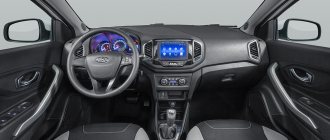Pros and cons of Kia Rio
Let's figure out why Rio is more expensive than Vesta, what are its pros and cons. I will tell you point by point.
Interior
I like the design, I don’t want to say that it is worse than Vesta’s. If we talk about the exterior and interior, then for some reason it reminds me of Star Wars. Especially the ass, if you look at the white car from behind, it's an imperial stormtrooper mask.
But everyone sees their own. There is no armrest in this configuration; I installed it myself. The salon is simple. Why do many people now buy Rio and not buy Solaris? Because even in the minimum configuration you will have air conditioning. In Solaris you will have to pay more for a car with air conditioning.
Here, even on the weakest 1.4-liter manual engine, you will have air conditioning, and that’s nice.
Chassis and ground clearance
In Russian road conditions, cross-country ability plays a big role. Car enthusiasts compared the ground clearance of the Russian Lada and that of the Korean. The ground clearance of the cars is 203 and 170 mm. The brainchild of AVTOVAZ will easily overcome any curb when parking.
The ground clearance of a Korean car (170 mm) is not suitable even for minor off-road conditions - the ground clearance is not enough, and the front overhang is long. While tests of Vesta show: overcoming uneven ground at a speed of 40-50 km/h, the suspension cannot be broken. To be fair, we note that it still won’t cope with deep potholes; suspension repairs after a race on roads damaged by winter frosts will be inevitable.
As for the design features, both cars have a comfortable MacPherson strut suspension at the front, and an independent rear suspension with a torsion beam. The Russian manufacturer equipped the Cross with front disc brakes and installed drums at the rear. The Rio comes with the same set as standard, but for an additional fee you can buy a top-end version of the Korean with rear disc brakes.
Seats
Sitting in the Kia Rio (now newsmakers will rejoice), you realize that the seats are much worse. There is no lumbar support on the driver's seat. I've had it on a Lada Vesta, and it's really comfortable. Although the seats are not bad, the lateral support is hard.
The upholstery is made of fabric, but I wouldn’t recommend using dermantine seats, everything will stick. The seats on the Lada Vesta are frankly better. Therefore, I will have to get used to it, and I’m not happy about it.
Comparison of Lada Vesta and Kia Rio in terms of appearance
Both models make a pleasant impression, so it is quite difficult to single out a leader in this aspect. The competitors' exteriors are fast and modern, but executed with completely different strokes of the designer's brush.
Car interior
Interesting!
It is absolutely clear that the KIA Rio and Hyundai Solaris are actually twins in technical terms and have the same “parent”. The latter is aimed more at serious people over 35 years old, the first was created with an eye on the young and impulsive generation.
- The entire image of the car is permeated with “flowing” features. The Kia Rio radiator grille is shaped like the nose of a predatory animal, and the narrow optics create the impression of a sly look. The air intake is decorated with a chrome baffle, and buyers also appreciate the fog lights that complement the look.
- Looking at the profile, you notice a slight forward roll. The side panels are framed with stylish stampings. The chrome grabs the window opening without disturbing the mirror and adds some sparkle.
- The rear end completes the look with large and harmonious taillights, a sloping roof and a neatly integrated trunk.
Lada Vesta is not going to give in, as it has a completely memorable image:
- The aggressive and dynamic style consists of classic headlights, a powerful air intake and an equally colorful radiator grille with rare veins of chrome. This exterior attracts people of all ages.
- The wheel rims on the profile side, as well as the “X-style” stampings on the door, define the car as a standard of pressure and courage.
- The back part with its especially large fragments makes you more and more zealously riveted on this dynamic beauty.
Visibility
If you compare the Kia Rio and Lada Vesta, the side pillar is much thinner and the visibility is better.
If you look at the mirrors, they are comfortable and make objects stand out well. But if you compare it with Vesta or Renault Sandero, which I also had before, I don’t understand why they made small mirrors on Rio.
Even Solaris has more mirrors. If we talk about the interior mirror, I even had to buy a panoramic one. The factory mirror is small and does not give an idea of the situation behind.
Prices and options
The two cars we are comparing are made according to different packaging principles. Vesta, even in its initial configuration for 780,000 rubles, has a large range of options: cruise and climate control, snow and rain sensors, parking sensors, speed limiter, navigation, rear view camera, 4 airbags.
While Kia offers this entire set of options only for 960,000 - 1,024,900 rubles in the maximum configuration. The manufacturer did not provide cruise control and a rain sensor function in the model, but offered a heated steering wheel and 6 airbags. We can conclude: when buying a Lada Cross, the consumer will receive more functions for less money.
Multimedia system
Let's talk a little about standard multimedia. The system is presented with a monochrome display. There is a USB connector; if the flash drive is not readable, you need to reformat it to another system.
There are 2 cigarette lighters at the bottom: one can connect a charger, the other can be used to operate the DVR. If you compare the Kia Rio and Lada Vesta in terms of the sound of music, then the latter is better even with a push-button radio. If we talk about a radio on Android and with good speakers, then it differs significantly in sound from the standard Kia Rio system.
It’s nice that the Rio has music controls on the steering wheel, it’s very comfortable. But I don't understand one thing. The equipment is quite rich, there is a heated leather steering wheel, seats with two-level heating. There is even a GLONASS system that works without a phone. But why can’t a cheap microphone be built into the radio so that you can connect your phone?
More expensive trim levels have this feature. On the Lada Vesta I had this option, but I had no luck with the radio - there was a slight defect. The interlocutor did not hear me because the microphone did not work well. Therefore, I had to change the radio and install it on Android.
There is no bluetooth on Rio, and the sound quality is poor. Therefore, I will change the radio along with the speakers. That's all about the cabin for now. The seats are less comfortable, the music is worse. Otherwise, in terms of ergonomics and ease of switching, these cars are approximately at the same level.
Riding around the balls
Lada Vesta will start first.
In several attempts, the result of the Lada Vesta was around 28 seconds. Externally, the ride looks purposeful without much body roll. It seems that now she will snatch the ball from the Kia Rio.
Kia-Rio: the rigid suspension does not give way to excessive rolls, the car clearly follows the snake.
In several races, the Kia Rio fought only with itself, winning the Lada Vesta by 2-2.5 seconds. He gets the decisive 1 ball.
Test Kia Rio - Lada Vesta: Kia Rio wins: 6:4
Is the difference of two balls worth the 120 thousand rubles that will have to be overpaid for the Kia Rio? My colleague Igor Sirin, having caught his breath a little after active taxiing, said, “yes, it’s worth it.” I’ll keep this money, let Lada Vesta still fight for it, run several tens of thousands of kilometers without breakdowns and with the same enthusiasm that she participated in today’s test. And let our journalistic work be of assistance to its creators and component suppliers in the battle for leadership in their own market.
Specifications below.
Bottom view
Now let's look at the Kia Rio from below and compare it with the Lada Vesta.
The underbody treatment is a gift from the dealer. Front suspension is MacPherson strut. The exhaust system mounting rubber bands are thick and decent. There are never any problems with them, the corrugation looks interesting.
There are 2 resonators installed, a large muffler, which will not work on Russian cars. It is also suspended by 2 thick elastic bands, which cannot be compared with Vesta.
The condition is still perfect, as the car is still running in and has driven less than 1000 km. The engine guard has cutouts, but you will have to remove it to change the oil. This is what the new 4th generation Rio looks like.
Engine
The 1.6 liter engine is the top unit for Rio, 150 N*m, acceleration to hundreds in 10.2 seconds. It belongs to the 4th generation, a phase shifter has been added for exhaust and intake. The engine is a little “strangled” under Euro-5, but this makes it possible for chip tuning. I will do this and try to improve the dynamic characteristics of Rio.
Vesta with a robot in the “comfort” configuration had acceleration on a 1.6 engine, according to the data sheet, 14.1 seconds. With tuning I achieved 12.3 seconds. It will be interesting in Rio, as the engine is very “strangled”.
Engine and transmission
Kia comes with quite good petrol units. The weakest of them is 100 horsepower. The more powerful one has 123 hp. With.
The cross is equipped with settings for 106 and a maximum of 122 hp. With. As you can easily see, there is no significant difference.
Rio accelerates to hundreds in 10 and 13 minutes, respectively, Vesta in 11 and 13.
When buying a Kia, you have the opportunity to choose an automatic transmission with 6 positions; the Cross may also have a five-speed robot, but it has not proven itself very well on older VAZ models. Drivers, in particular, complained that the transmission responded with a certain delay. For lovers of dynamics, we recommend choosing a manual transmission - it is much more successful and works well.
Noise insulation
The wheel arches are already taped from the factory. Many people complain that the Kia Rio has very poor sound insulation. Maybe this was on earlier cars. This car has a hood guard.
There is also vibration isolation on the wheel arches from the engine compartment. I would not say that at a speed of 140 km per hour there are differences in noise in the cabin from the Vesta - about the same. But I will improve the sound insulation in the future.
There is a small vibration insulation pasted in the trunk; there is no sound-insulating material there.
The Lada Vesta still had thick pile, so the noise from the trunk was a little less. Here plywood with carpet and a rug are placed on top of the wheel. Therefore, if you are driving on a country dirt road, the noise will be a little more than on Vesta. But this is not critical, as many say.
Exterior of Kia Rio and Lada Vesta
The appearance of the Kia Rio is made in the family tradition of the brand - the style of flowing lines. The radiator grille in the shape of a “tiger nose”, narrowed and long lights, an air intake with a chrome partition and fog lights look really beautiful. The appearance of the car is slightly tilted forward, with original stampings running along the sides. The chrome window lines, domed roof and tail, with large headlights, are quite attractive. In general, the car looks very modern - this attracts young people.
As for the Lada Vesta, it is in no way inferior. It replaces fine lines with an aggressive appearance. The lights are classic, the radiator grille and air intake are connected together with curving chrome lines - all this together looks very modern. This look will suit any client. The external profile is also impressive. From the side you can see X-shaped panel lines, original wheel rims - all together add prestige. The rear view is also gorgeous - the individual headlights look great along with the chrome Lada name.
Doors
On Vesta there is no seal on the door, the seal is only on the body. The Kia Rio has a complete seal along the body and door contour.
On Vesta there is a controversial solution - there is a flap at the bottom, which sometimes covers the drainage holes. There is no seal at the bottom, but there is a good seal along the contour of the door. You won't freeze in winter.
Bumper height
You can drive up to the curb and not hit anywhere. There remains a gap of less than 1 cm.
Whether I did the right thing by selling Vesta and taking Rio, only time will tell. These will be tests in winter, speed measurements. Let's look at Rio's reliability in terms of penetrability of the suspension, the operation of the electrical part, and how much it can be tuned. Let's try to improve the dynamic parameters. I will also try to tell you about this.











